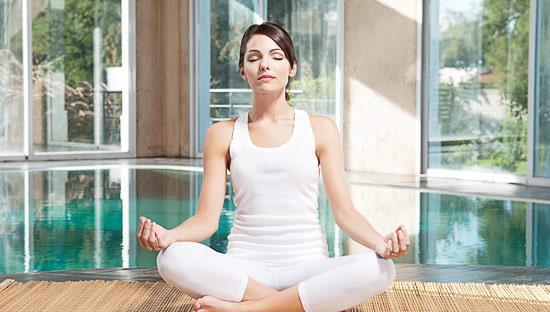664
Cleansing breath: Kapalabhati

Kapalabhati pranayama - cleansing breath. The literal translation - "enlightenment skull", meaning "clean" pranic channels that are in the skull (nasal cavity, partitions and other guides, which moves prana). Unlike regular breathing during which exhalation breath is always active in Kapalabhati active and sharp exhale and inhale passive. In addition, almost all the techniques of pranayama breath longer (twice as long as inspiration) and Kapalabhati - on the contrary - short and sharp air emissions, which are accompanied by calm and slow breaths.
It can recommend Kapalabhati as the first exercise in each session of pranayama, and at the beginning of each series of asanas to clean the lungs from the remnants of the exhaust air and promote good blood oxygen saturation.
Technique:
Sit in any comfortable position with your back straight.
Fingers of both hands can be kept Chin or Gyana- ("Dzhnyana-") mudra.
We begin to make active, noisy breaths through the nose; breath - spontaneous, due to relaxation of the stomach. Speed of execution - about 1 (beginners) -2 (advanced) cycle of breathing (inhale-exhale) per second. You can breathe out simultaneously with the movement of the second hand watches.
The practice is traditionally done in 3 sets of 20-50 cycles, or at the time - 5-7 minutes as needed respite.
If machinery has become comfortable for you, increase the number of breaths in the approach, and can also make the delay.
Beginners are recommended to delay expiration (because they have a cathartic effect), for experienced yogis - inspiratory (as they energize the body already cleared).
In case of delay on the exhale experienced practitioners do 3 bandha ("Castle"): Jalandhar Bandha, Uddiyana bandha and then Moola bandha - in that order: from top to bottom, as it were.
Remove the bottom up bandha - Mula, Uddiyana, Jalandhar. In case of delay on the breath does two bandha: Mula bandha and Jalandhar bandha.
First, concentrate on the correct execution of the exercise: the force of exhalation, smooth inhalation frequency performance. Make sure that the chest is convex and motionless, and his face relaxed. Later, when you have mastered the technique, concentrate on the area below the navel (lower abdomen). It was at this point should be the maximum muscle contraction at the time of expiration. When you relax, also concentrate on this area.
Runtime Errors:
There is a tendency to equate the duration of the exhalation and the subsequent inspiration. However, excessive muscle tension press this error - the most common. Inhalation should be at least three times longer than the exhalation. Balancing them, we lose the power we need. The main thing in this exercise - power exhalation.
Contraindications:
For this practice, there are the same limitations as other practices of pranayama. People suffering from pronounced lung diseases, should refrain from this exercise. Those who have a heart condition, can perform Kapalabhati, but they will need a long period of preparation by the breath to control the muscles of the abdomen. In principle, the disease is not a deterrent. In this case, it only indicates that the lungs are not in the best condition, and you must be very careful.
Japanese method to remove the stomach and straighten your back - minus 4 cm in 5 minutes a day.
TONIC turmeric, revitalizes the entire body.























